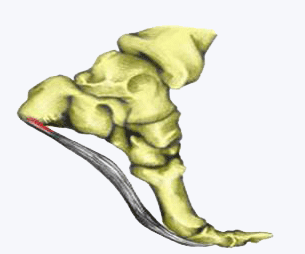 A very common and very annoying source of heel pain is plantar fasciitis. Plantar fasciitis was traditionally thought to be an inflammatory condition. However, the cause of pain and dysfunction is now thought to be degeneration of the collagen fibers close to the attachment to the calcaneus (heel bone). The plantar fascia is a broad, thick band of tissue that runs from under the heel to the front of the foot (see Image 1).
A very common and very annoying source of heel pain is plantar fasciitis. Plantar fasciitis was traditionally thought to be an inflammatory condition. However, the cause of pain and dysfunction is now thought to be degeneration of the collagen fibers close to the attachment to the calcaneus (heel bone). The plantar fascia is a broad, thick band of tissue that runs from under the heel to the front of the foot (see Image 1).
The heel pain associated with plantar fasciitis occurs on the bottom of the affected heel usually towards the inside where the plantar fascia attaches to the calcaneous (heel bone). Often the pain is the worst first thing in the morning or after prolonged sitting as the fascia tightens up during this time. After a few minutes of moving around the pain eases as the fascia gets warmed up. As the condition becomes more severe the pain can get worse throughout the day.
The most common cause of plantar fasciitis is poor foot mechanics. Most commonly, a person suffering from plantar fasciitis will over-pronate (roll in) their foot which produces repetitive over-stretching of the plantar fascia. Other foot conditions can also lead to plantar fasciitis such as high arches (pes cavus), flat feet (pes planus) or rolling out on your feet (supination). Poor footwear that does not provide adequate arch support has been attributed to plantar fasciitis. In addition, overweight and pregnant individuals are more at risk of developing the condition.
Plantar fasciitis can be very frustrating to treat as it is often slow to respond. Addressing any foot mechanic issues with proper footwear and a gait assessment are key components of treatment. Keep off your feet, avoid walking barefoot, apply ice and use anti-inflammatory medications (such as ibuprofen or naproxen). Have a custom footwear fitting done to ensure that your feet are being adequately supported. A gait analysis by a certified pedorthist will determine if you have any mechanical foot issues. They can then produce a custom orthotic if required to restore your normal foot biomechanics. Night splinting will gently stretch the calf muscles and plantar fascia overnight preventing them from tightening up.
